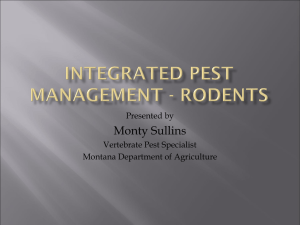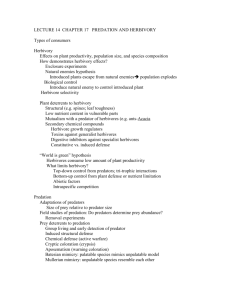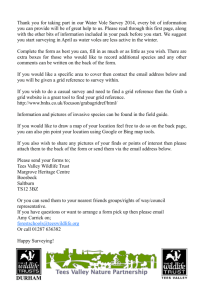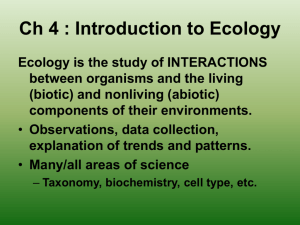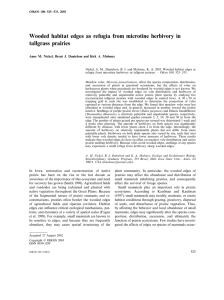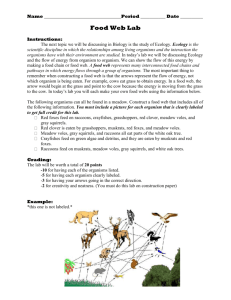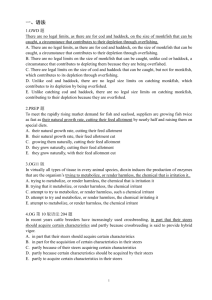Wooded habitat edges as refugia from microtine herbivory in tallgrass prairies
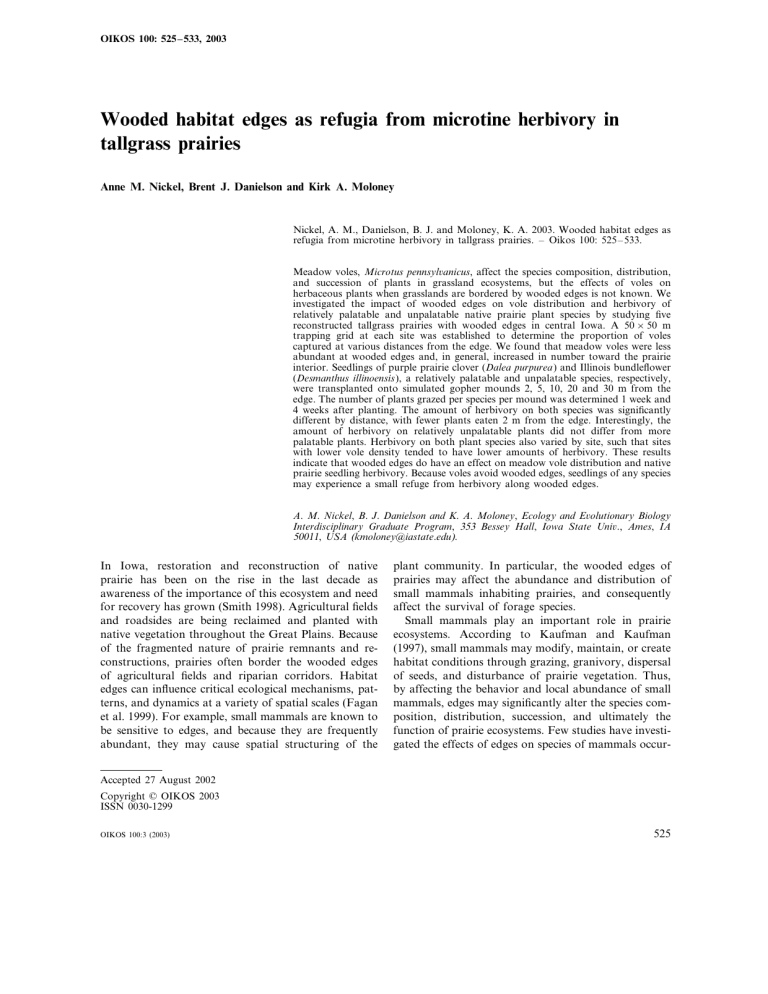
OIKOS 100: 525 – 533, 2003
Wooded habitat edges as refugia from microtine herbivory in tallgrass prairies
Anne M. Nickel, Brent J. Danielson and Kirk A. Moloney
Nickel, A. M., Danielson, B. J. and Moloney, K. A. 2003. Wooded habitat edges as refugia from microtine herbivory in tallgrass prairies. – Oikos 100: 525 – 533.
Meadow voles, Microtus pennsyl
6 anicus , affect the species composition, distribution, and succession of plants in grassland ecosystems, but the effects of voles on herbaceous plants when grasslands are bordered by wooded edges is not known. We investigated the impact of wooded edges on vole distribution and herbivory of relatively palatable and unpalatable native prairie plant species by studying five reconstructed tallgrass prairies with wooded edges in central Iowa. A 50 × 50 m trapping grid at each site was established to determine the proportion of voles captured at various distances from the edge. We found that meadow voles were less abundant at wooded edges and, in general, increased in number toward the prairie interior. Seedlings of purple prairie clover ( Dalea purpurea ) and Illinois bundleflower
( Desmanthus illinoensis ), a relatively palatable and unpalatable species, respectively, were transplanted onto simulated gopher mounds 2, 5, 10, 20 and 30 m from the edge. The number of plants grazed per species per mound was determined 1 week and
4 weeks after planting. The amount of herbivory on both species was significantly different by distance, with fewer plants eaten 2 m from the edge. Interestingly, the amount of herbivory on relatively unpalatable plants did not differ from more palatable plants. Herbivory on both plant species also varied by site, such that sites with lower vole density tended to have lower amounts of herbivory. These results indicate that wooded edges do have an effect on meadow vole distribution and native prairie seedling herbivory. Because voles avoid wooded edges, seedlings of any species may experience a small refuge from herbivory along wooded edges.
A .
M .
Nickel , B .
J .
Danielson and K .
A .
Moloney , Ecology and E
6 olutionary Biology
Interdisciplinary Graduate Program , 353 Bessey Hall , Iowa State Uni
6
., Ames , IA
50011 , USA ( kmoloney@iastate .
edu ) .
In Iowa, restoration and reconstruction of native prairie has been on the rise in the last decade as awareness of the importance of this ecosystem and need for recovery has grown (Smith 1998). Agricultural fields and roadsides are being reclaimed and planted with native vegetation throughout the Great Plains. Because of the fragmented nature of prairie remnants and reconstructions, prairies often border the wooded edges of agricultural fields and riparian corridors. Habitat edges can influence critical ecological mechanisms, patterns, and dynamics at a variety of spatial scales (Fagan et al. 1999). For example, small mammals are known to be sensitive to edges, and because they are frequently abundant, they may cause spatial structuring of the plant community. In particular, the wooded edges of prairies may affect the abundance and distribution of small mammals inhabiting prairies, and consequently affect the survival of forage species.
Small mammals play an important role in prairie ecosystems. According to Kaufman and Kaufman
(1997), small mammals may modify, maintain, or create habitat conditions through grazing, granivory, dispersal of seeds, and disturbance of prairie vegetation. Thus, by affecting the behavior and local abundance of small mammals, edges may significantly alter the species composition, distribution, succession, and ultimately the function of prairie ecosystems. Few studies have investigated the effects of edges on species of mammals occur-
Accepted 27 August 2002
Copyright © OIKOS 2003
ISSN 0030-1299
OIKOS 100:3 (2003)
525
ring in native or reconstructed prairies (but see Ostfeld et al. 1997, Patitschniak-Arts and Messier 1998, Manson et al. 1999, and Manson et al. 2001 for studies in old fields). As the number of small-scale prairie reconstructions and the desire for them to function as a native prairie increases, the study of edge effects on prairie small-mammal and plant communities becomes more crucial.
One small mammal, the meadow vole ( Microtus pennsyl 6 anicus ), is of particular interest for edge studies because of its high abundance and widespread distribution. Meadow voles are the dominant small-mammal species in herbaceous habitats of eastern North America (Ostfeld and Manson 1996), and throughout the tallgrass prairie region (Wilson and Ruff 1999).
Meadow voles prefer mesic grassland habitats and tend to avoid woody vegetation (Getz 1985). They are primarily herbivores, eating grasses, sedges, and forbs
(Batzli 1985), but are also known to eat seeds, insects, and fungi (Lindroth and Batzli 1984). Howe and Brown
(1999) recognized the impact of meadow vole herbivory on plant communities. They found that voles reduced forb biomass by 35 and 57% in high- and low-density plantings of tallgrass prairie, and reduced forb diversity by 4 and 25%, respectively. In a study in old-field habitats, Ostfeld et al. (1997) found that meadow voles avoided forested edges, as evidenced by lower predation on tree seedlings on edges than \ 5 m into the field.
They concluded that the lower activity of voles has a profound effect on the survival of tree propagules on edges, and that the distribution of meadow voles relative to forest edges influences the composition and distribution of plant species. Because of the potential influence these small mammals may have on the composition and distribution of herbaceous communities,
Ostfeld and Canham (1993) suggest the population dynamics of voles be viewed as a keystone process.
The potential effects of meadow voles on plant communities may be mediated by the palatability of individual plant species in the community. Mechanical and chemical defensive strategies against herbivory help determine the palatability of plants. Mechanical defenses such as pubescence, thorns, silica crystals in tissues, and production of waxes or resins discourage or impede plant herbivory (Fernandes 1994). Many plants contain secondary metabolites such as terpenoids, nitrogen-containing compounds, and phenolics to serve as a chemical defense against herbivory (Crawley 1997). These metabolites may be distasteful to herbivores, resulting in a wide spectrum of relative palatabilities in plant species. According to Fenner et al. (1999), the relative palatability of plants in a grazed community is a key determinant of the community’s species composition.
Ostfeld and Canham (1993) also felt that the palatability of tree seedlings played a role in the levels of predation by voles observed in their study. Incorporating plant palatability into the broader question concerning small mammal herbivory will strengthen our understanding of voles’ effects on prairie plant communities.
Our study investigated the impact of wooded edges on meadow vole distributions in Iowa tallgrass prairie reconstructions and the subsequent effects on native prairie vegetation. Specifically, we examined 1) the distribution of meadow voles from wooded edges to prairie interiors and 2) the patterns of herbivory by meadow voles on relatively palatable and unpalatable native seedlings as a function of distance from wooded edges. We hypothesized that meadow voles would avoid wooded edges and increase in abundance in prairie interiors. Voles may avoid edges due to habitat requirements (Manson et al. 1999) or if predation risk is increased by predators using the edge (Lima and Dill
1990). This distributional gradient of meadow voles would result in lower rates of herbivory on prairie seedlings near the wooded edge. We expected both palatable and unpalatable seedlings to show this response but anticipated that the magnitude of the response would vary. Herbivory on palatable seedlings should be much higher than herbivory on unpalatable seedlings at intermediate and far distances from the edge. Experimental support of these hypotheses could reveal the significance of wooded edges, not only on the distribution of small mammals, but on the composition and distribution of native prairie plants.
Methods
Study sites
Five reconstructed tallgrass prairie sites near Ames, IA were targeted for study: Kurtz (42°7
%
N, 93°12
%
W), Mc-
Farland 1 (42°5 % N, 93°34 % W), McFarland 2 (42°6 % N,
93°34 % W), Ledges (41°59 % N, 93°52 % W), and Big Creek
(41°47 % N, 93°44 % W). Kurtz prairie was a 1.2 ha privately-owned, 6-year-old big bluestem / switchgrass ( An dropogon gerardii / Panicum 6 irgatum ) prairie in
Marshall County, IA. McFarland 1 and 2 were located at McFarland Park, a Story County Conservation Park
6 km northeast of Ames, IA. McFarland 1 was a 5.7
ha, 25-year-old, poor-quality switchgrass prairie with large infestations of crown vetch ( Coronilla 6 aria ). Mc-
Farland 2 was a 1.5 ha forb-rich, 5-year-old big bluestem prairie. The 3.2 ha prairie at Ledges State
Park in Boone County, IA, was approximately 20 years old and was dominated by switchgrass and reed canary grass ( Phalaris arundinacea ). The final site was a 0.8 ha,
20-year-old big bluestem / switchgrass prairie at Big
Creek State Park in Polk County, IA.
Each prairie had a continuous wooded edge at least
100 m long. Kurtz, McFarland 2, and Big Creek had south-facing edges, while McFarland 1 and Ledges had east-facing edges. The trees of all the edges were ap-
526
OIKOS 100:3 (2003)
proximately 10 m tall, but the thickness of the wooded habitat varied from 2 to 30 m.
Determination of relative palatabilities
Laboratory trials of consumption of plants by meadow voles were conducted from April through July 2000 to determine which native prairie seedlings were palatable and unpalatable for use in the field study. Plant species tested included lead plant ( Amorpha canescens Pursh), indigobush amorpha ( Amorpha fruticosa L.), wild blue indigo ( Baptisia australis [L.] R. Br.), prairie coreopsis
( Coreopsis palmata Nutt.), purple prairie clover ( Dalea purpurea Vent.), Illinois bundleflower ( Desmanthus illi noensis [Michx.] MacM. ex B. L. Robinson & Fern.), purple coneflower ( Echinacea pallida [Nutt.] Nutt.), alum root ( Heuchera richardsonii R. Br.), blazing star
( Liatris aspera Michx.), and prairie violet ( Viola pe datifida G. Don). These species were chosen for testing because they are all common, endemic tallgrass prairie forbs. In each trial, one native species was tested against black medic ( Medicago lupulina ), a naturalized forb native to Eurasia. Black medic has been shown to be palatable to voles in previous trials (Danielson, unpubl.), so it could be used to indicate the relative palatability of native species. The placement of eight seedlings of each species into a 4 × 4 tray was randomized by a latin square design. The tray consisted of 4
1204-size plastic inserts placed in a 19 × 19 × 6 cm plastic tray, and individuals were transplanted into a cell of the insert. Meadow voles were live-trapped from an area marsh and brought into the laboratory around
8 a.m. for a palatability trial. Individuals were each placed in a 38 l aquarium containing sawdust bedding, a 10 cm-diameter glass water dish, and a 10 × 12 cm cardboard ‘‘tent’’ for hiding. Approximately 2 – 5 hours later, the tray of plants was placed in an aquarium with a meadow vole for three hours. The percentage of each species eaten was determined by scoring individual plants as not eaten, half eaten, or entirely eaten. Voles were then released into the field, so individuals were only used once in the lab trials. Six trials on the herbivory of each native species compared to black medic were completed using a total of 60 voles.
10 m apart along the forest edge, as well as at distances
5, 10, 20, 30, and 40 m perpendicular to the edge. The
5 m distance was used to facilitate greater resolution of small-mammal movement near the edge. Two Sherman live traps were placed at each station, for a total of 60 live traps at 30 trap stations. To reduce any influence of nearby edges, the grid was positioned so that there was at least 30 m of open prairie on the 3 non-edge sides of the grid. The traps were baited with oats and locked open for 2 days, and then set for 5 days. Traps were checked each morning of the 5 days; small mammals were ear-tagged, sexed, and weighed, and traps were re-set each afternoon. The trapping regime was repeated at all sites approximately 4 weeks after the initial week of trapping. The dates of the second trapping session were 10 – 14 July 2000 for Kurtz, McFarland 1, and McFarland 2, and 24 – 28 July 2000 for
Ledges and Big Creek. Vole density was calculated by averaging the minimum number of voles known alive for the two trapping sessions at each site. Because the area of each trapping grid was the same, the density is expressed as the number of individual voles per site.
After one small-mammal trapping session was completed at all sites, experimental planting units were established at each site within the 50 × 50 m trapping grid. The experimental design consisted of four plots spaced 10 m apart parallel to the forested edge, repeated at 2, 5, 10, 20, and 30 m from the edge, for a total of 20 plots (Fig. 1). At each plot, approximately
Field methods
Small-mammals were trapped to determine the density and distribution of meadow voles at each site. Because of the distance between sites and time needed to check traps, trapping occurred during two consecutive weeks:
12 – 16 June 2000 for Kurtz, McFarland 1 and McFarland 2, and 19 – 23 June 2000 for Ledges and Big Creek.
Permanent trap stations were established in a 50 × 50 m grid at each site (Fig. 1). Five trap stations were spaced
Fig. 1. Design of small mammal trapping and herbivory experiment at five reconstructed prairie sites in central Iowa. ‘x’ represents location of a Sherman live trap. The boxes represent the location of a mound on which seedlings were transplanted.
Each square represents a different plant species and each circle represents an individual plant.
OIKOS 100:3 (2003)
527
7.5 l of topsoil were deposited on the ground to simulate a pocket gopher ( Geomys bursarius ) mound. The mounds serve as small-scale disturbances which provide opportunities for forb colonization (Peart 1989, Wolfe-
Bellin and Moloney 2000). In this study, mounds created homogeneous microhabitats for planting seedlings and provided a realistic condition for the presence of numerous forb seedlings. Mounds also helped to eliminate other environmental effects that may be connected with distance from edges (e.g. moisture, plant density, light availability, etc.). On each mound, nine plants each of a palatable species and an unpalatable species were planted approximately one inch apart in an array
(Fig. 1). Based on the laboratory trials and the desire to use leguminous species that are easy to grow, purple prairie clover ( Dalea purpurea ) was used as the relatively palatable species, and Illinois bundleflower ( Des manthus illinoensis ) as the relatively unpalatable species
(see Results). Each species was planted in a 3 × 3 array, the two arrays were adjacent to one another, and the position of the species (right or left side of the array) was randomized. Purple prairie clover and Illinois bundleflower were planted at four sites in this manner, but due to an insufficient number of Illinois bundleflower seedlings, lead plant ( Amorpha canescens ) was substituted as the unpalatable species at the fifth site (Kurtz).
Initial palatability trials indicate Illinois bundleflower and lead plant are both relatively unpalatable to voles
(see Results), but statistical analyses for the unpalatable species did not include lead plant. Seedlings were transplanted onto the mounds 18 – 20 July 2000. Because herbivory at the seedling stage results in the death of individual plants, we recorded herbivory as the number of stems clipped per species per plot 1 week and 4 weeks after planting.
Results
Live-trapping indicated that meadow voles were less abundant at the edge and increased toward the prairie interior (ANOVA, p = 0.037). The proportion of voles captured along the edge was very low for all sites, and at three high vole-density sites (22 – 49.5 mean MNA), the proportion of captures generally increased with increasing distance from the edge (Fig. 2a). At the remaining two sites, this pattern was not as apparent because of low vole densities (5.5 – 8.5 mean MNA), but even so, fewer voles were captured at the edge (Fig. 2b).
While there was a definite edge effect, the response by voles to the edge was not linear, nor was the edge effect very wide.
Laboratory trials revealed that five native species were significantly less palatable than our standard forage plant, Medicago lupulina , using paired t-tests (Table
1). Prior to statistical tests, the data were arcsine
Fig. 2. The within-site proportion of vole captures at six distances from the wooded edge for high vole-density sites (a) and low vole-density sites (b) over two trapping sessions
(dotted line = site not used in unpalatable species analyses).
square-root transformed. The percent herbivory was significantly greater on Medicago lupulina than on each of the native species Amorpha canescens , A .
fruticosa ,
Desmanthus illinoensis , Heuchera richardsonii , and Viola pedatifida (p B 0.05), which we hereafter refer to as
‘‘unpalatable’’. The remaining five native species are relatively palatable, since there was not a statistically significant difference in the percent herbivory of these five natives versus Medicago lupulina . The two species chosen for use in the field study, Dalea purpurea and
Desmanthus illinoensis , were among the most palatable and least palatable according to our tests.
Despite laboratory trials indicating that Desmanthus illinoensis was less palatable than Dalea purpurea , there was no significant difference in the number of unpalatable versus palatable plants eaten in the field (t-test on
528
OIKOS 100:3 (2003)
Table 1. Paired t-tests compare the amount of herbivory of 10 species of native tallgrass prairie plants versus herbivory of
Medicago lupulina in laboratory trials. Significant values (p B 0.05, *) indicate the native species that were eaten significantly less than M .
lupulina , and were therefore classified as relatively ‘‘unpalatable’’. No plant was eaten significantly more often than M .
lupulina . The maximum mean difference in herbivory of M .
lupulina versus each native species is 8 plants.
Species Mean difference in herbivory Medicago – native
SD of difference Relative Palatability
Amorpha canescens
Amorpha fruticosa
Baptisia australis
Coreopsis palmata
Dalea purpurea
Desmanthus illinoensis
Echinacea pallida
Heuchera richardsonii
Liatris aspera
Viola pedatifida
2.0*
4.17*
2.08
0.25
0.67
4.92*
2.58
3.08*
1.25
3.0*
2.17
3.14
2.50
0.42
1.63
2.56
3.48
2.54
1.97
2.51
unpalatable unpalatable palatable palatable palatable unpalatable palatable unpalatable palatable unpalatable difference, p = 0.33 after 1 week, p = 0.12 after 4 weeks). There was, however, a significant difference in the percentage of plants eaten at different distances from the edge (Fig. 3a and b). A 2-way analysis of variance (ANOVA) was used to analyze the effects of site, distance, and the site-distance interaction on the amount of herbivory of relatively palatable and unpalatable species after 1 week and 4 weeks (SAS v. 8.1;
Table 2). Distance had a significant effect on herbivory of less palatable plants after 1 week (p = 0.002), and a marginally insignificant effect after 4 weeks (p = 0.08).
Distance also had a significant effect on herbivory of the more palatable plants after both 1 week and 4 weeks (p B 0.0001 for both time intervals). Fig. 3 indicates that both species of plants were eaten less at 2 m from the edge than the other distances. This difference between 2 m and the other distances is significant except for the relatively unpalatable species at 4 weeks
(p B 0.01 using Scheffe’s multiple comparisons adjustment for any possible contrast).
Although seedlings in the field were susceptible to herbivory by other herbivores such as deer and rabbits, we are confident the herbivory we observed was primarily due to meadow voles. Deer were occasionally observed in the vicinity of the sites, but not in the grids, and rabbits were never observed at any of the sites. An abundance of meadow vole fecal material on the mounds also indicated plants were not eaten by other herbivores. Even if deer and rabbits were active on the sites, we would expect herbivory patterns opposite of our observations. Meiners and Martinkovic (2002) found that herbivory of red oak tree seedings by both deer and rabbits decreased significantly from forest interiors to old-field interiors. Had these mammals been depredating the seedlings in our study, we would likely have observed more herbivory at the wooded edge instead of less.
The percent herbivory of the more palatable species varied significantly by site after both 1 and 4 weeks, and after 1 week for the less palatable species (Table 2).
Part of the difference in herbivory among sites was
Fig. 3. Mean percent herbivory of unpalatable and palatable seedlings after a) one week, and b) four weeks as a function of distance from the wooded edge.
OIKOS 100:3 (2003)
529
Table 2. Summary statistics of the ANOVA model examining the effects of site and distance on the amount of herbivory of relatively unpalatable and palatable species after 1 week and 4 weeks.
Source of variation
Unpalatable species ss df F p Source of variation
Palatable species ss df F p
1 week site
Distance site × distance error total
4 weeks site
Distance site × distance error total
86.16
134.27
126.81
415.75
762.99
3.01
18.39
26.08
126.00
173.48
3
4
12
60
79
3
4
12
60
79
4.14
4.84
1.53
0.48
2.19
1.03
0.0098
0.0019
0.1404
0.6987
0.0809
0.4300
site distance site × distance error total site distance site × distance error total
145.22
259.42
144.71
447.75
997.10
112.09
100.84
58.52
235.63
507.08
4
4
16
75
99
4
4
16
75
99
6.08
10.86
1.51
8.92
8.02
1.16
0.0003
0.0001
0.1169
0.0001
0.0001
0.3162
related to the average vole density. A linear contrast on the portion of site variance attributable to vole density was estimated in the ANOVA model. A linear contrast in an ANOVA model partitions the variance of a main effect into a linear component and leftover variance, and tests whether the linear component explains a statistically significant portion of the main effect variance (Ramsey and Schafer 1997). The linear contrast for vole density was significant for the more palatable species at both time intervals (p = 0.0027 and 0.004, respectively), and for the less palatable species after 1 week (p = 0.048). This indicates that vole density explained a statistically significant portion of the variance in herbivory by site. The pattern of increased herbivory with increasing vole density was strongest after 1 week, although after 4 weeks, there was still less herbivory at low-density sites than medium to high-density sites
(Table 3).
Discussion
Wooded edges had an effect on meadow vole distribution and native prairie seedling herbivory in Iowa tallgrass prairie reconstructions, as predicted. Meadow voles were less abundant at the wooded edge than all other distances toward the prairie interior. Comparing high vole-density sites (Fig. 2a) to low vole-density sites
(Fig. 2b), it appears that wooded edges play a role in the way in which meadow voles fill habitats. At low densities, voles are found in low numbers at all distances except the edge, where they are almost absent.
As vole numbers increase, however, the proportion of voles found in the prairie interior increases greatly while the proportion found at and near the edge remains low. Voles seem to preferentially occupy habitat that is far from the wooded edge ( \ 10 m). Two probable causes for this pattern are microhabitat changes and an increased risk of predation near the edge. Meadow voles are strictly grassland dwellers; rarely do they enter forested habitats (Wilson and Ruff
1999). Because the habitat changed abruptly from grassland to woody vegetation in our study, it is not surprising that we found few voles at the wooded edge, but considerably more as close as 5 – 10 m from the edge.
Predation pressure also may contribute to the observed distribution pattern. Predators of meadow voles include raptors like owls and hawks, and a variety of mammals such as fox, opossum, raccoon, skunk, badger, weasel, mink, and coyotes (Pearson 1985). Most of these predators are thought to use wooded edges as
Table 3. Mean Minimum number known alive density of voles per site and mean percent herbivory of unpalatable species and palatable species after one and four weeks for each site. Standard deviation of the mean percent herbivory is in parentheses.
*Lead plant is the unpalatable species at Kurtz; Illinois bundleflower is the unpalatable species at the other sites.
Site Mean Vole Density Mean % Herbivory unpalatable
1 week palatable unpalatable
4 weeks palatable
Kurtz*
McFarland 2
Big Creek
McFarland 1
Ledges
5.5
8.5
22.5
28.0
49.5
55.8 (1.58)
57.5 (0.95)
80.3 (1.72)
88.9 (2.10)
78.3 (2.84)
51.7 (1.52)
55.0 (0.99)
82.5 (1.58)
83.3 (2.83)
72.5 (3.39)
70.0 (1.67)
95.0 (0.64)
99.2 (0.15)
93.6 (1.29)
95.8 (0.84)
65.8 (1.35)
88.6 (1.14)
100.0 (0.00)
87.8 (2.46)
95.6 (0.89)
530
OIKOS 100:3 (2003)
perches while searching for prey or as corridors for travel (Marini et al. 1995), although direct evidence of increased predation along wooded edges has been difficult to obtain (Heske 1995, Heske et al. 1999).
Winter et al. (2000) found the activity of mid-sized mammalian grassland nest predators tended to increase with increasing proximity to wooded edges, which suggests that voles may avoid edges to reduce the risk of predation. In a study on Tengmalm’s owls ( Aegolius funereus ) in Norway, Jacobsen and Sonerud (1993) found that the amount of ground vegetation influenced where the owls hunt. These owls employ a pause-travel mode of hunting in which they perch in trees to locate their prey auditorily. When the ground became snowfree in early spring, the owls hunted more in clear-cuts, but when the ground vegetation of the clear-cuts became denser in late spring, they switched to hunting in the forest. This suggests that it may be difficult for raptors to find prey items in grassland vegetation that is far from the edge. Sonerud (1992) also reported that for hawk owls ( Surnia ulula ), which hunt similarly to Tengmalm’s owls, shorter attack distances from the perch were more successful. Both of these studies suggest why the edge effect in our study was present, but not very wide.
Even though the zone of influence of the wooded edge on vole distribution is narrow, it is biologically important. Both the relatively palatable and unpalatable plant species were eaten less at 2 m from the edge than at the other distances (Fig. 3). We believe that edges may therefore provide a small, yet important, refuge for native seedling establishment. After 4 weeks in the field, 92 – 100% of all seedlings at 5 – 30 m distances from the edge had been eaten, whereas 66% of the more palatable and 86% of the less palatable seedlings were eaten at 2 m from the edge (Fig. 3b).
Because voles avoid edges, the risk of herbivory is reduced, and seedlings have a greater chance of establishment near wooded edges. Consequently, wooded edges may be beneficial to prairie plant species, especially those species that rely more heavily on seedling recruitment for continued existence.
The length of time that wooded edges serve as a refuge for prairie plants is unclear, and may vary depending on the nature of the wooded edge and prairie management practices. If tree seedlings begin to invade the prairie, the habitat will become degraded and edges will have an overall negative impact on prairie plants. Voles may be able to prevent invasion at further distances from the edge by their herbivory on tree seedlings, but may not be able to fully stop invasion near the edge (Ostfeld et al. 1997). In our study, however, ‘‘hedgerow’’-type edges did not appear to be invasive, and invasion from thicker woods could be prevented with standard prairie management such as cutting brush and burning. Prairie seedlings, therefore, should still enjoy at least a temporary refuge along wooded edges, and with management to prevent woody invasion, the duration of the refuge could be prolonged.
Seemingly, native prairie seedlings may never become established in prairie interiors due to the high rates of herbivory by meadow voles. However, vole populations are well-known for their dramatic temporal variationpopulations are not maintained at high densities for long periods of time (Krebs and Myers 1974, Taitt and
Krebs 1985, Getz et al. 1987, Getz and Hofmann 1999).
We found that vole density explained a significant portion of the variance in herbivory by site, with less herbivory at low vole-density sites and greater herbivory at high vole-density sites (Table 3). During periods of high density, prairie seedlings may indeed be unable to survive in prairie interiors due to the high rates of herbivory. But in low vole-density periods, seedlings may have a chance to escape herbivory and survive, even in prairie interiors. These findings are consistent with other research showing that small-mammal herbivores at high densities affect plant communities (Brown and Heske 1990, Bergeron and Jodoin
1993, Ostfeld and Canham 1993).
The most surprising result of this study was the lack of a difference in depredation of relatively palatable and unpalatable seedlings in the field. The laboratory trials indicated clear differences in the palatability of several species, but in the field, the amount of herbivory on relatively palatable and unpalatable seedlings was not statistically different. Seasonal differences between when the lab study and field study were conducted may account for this phenomenon. Laboratory trials for the species used in the field were performed from late April to mid June, but the herbivory experiment did not begin until late July. Meadow voles brought into the lab earlier in the season may have been satiated and could therefore afford to discern between palatable and unpalatable species. By late July, voles in the field may have been experiencing shortages of preferred green shoots, restricting them from the luxury of choosing between species. In fact, any seedling at this time of the year may be ‘‘relatively palatable’’ and worth eating because of the scarcity of seedlings in the habitat.
An alternative explanation lies in the observation that some plants scored as depredated were clipped but not eaten. The number of mounds on which clipped seedlings of either species occurred was noted, but unfortunately, the number of individual plants that were clipped was not recorded. Uneaten clippings of
Illinois bundleflower, a less palatable species, were found on 28 of 80 mounds, while clippings of purple prairie clover, the relatively palatable species, were found significantly less on 3 of 80 mounds ( x 2 = 25.0, p
B
0.005). Although clipping is the same as herbivory from the plant’s point of view, voles may have found
OIKOS 100:3 (2003)
531
Illinois bundleflower distasteful only after sampling them, resulting in the appearance of not distinguishing between relatively palatable and unpalatable species. In the field, voles may not take the time to choose between palatable and unpalatable species until after they have sampled them due to predation risk.
While the clipping behavior is most likely due to sampling plants, meadow voles may also use clipping as a means of modifying their environment. Meadow voles depredated tree seedlings in Ostfeld and Canham’s
(1993) study, but this was not viewed as having a functional role in their nutrition since the trees were not eaten. As tree seedlings invade grassland habitat, habitat quality diminishes, so the clipping of tree seedlings by voles may be a mechanism for maintaining preferred habitat. A similar behavior may have occurred in our study, whereby voles use clipping as a means to remove distasteful species from their environment. Future research on this question is warranted and could reveal some intriguing vole-plant interactions.
We have demonstrated that wooded edges along tallgrass prairie reconstructions influence both the small-mammal and plant communities. Meadow vole abundance changes with respect to wooded edges and vole herbivory on native prairie seedlings is reduced at the edge. This results in a small area of refuge for seedlings near wooded edges. Meadow voles undoubtedly impact the distribution of native forbs in prairie ecosystems through their own distribution, population density, and perhaps behavior. That wooded edges are capable of changing the interaction between voles and prairie plants is of great consequence in our overall understanding of how prairies function in such a fragmented ecosystem.
Acknowledgements – We thank Kelly Wolfe-Bellin for her help in designing and completing the lab palatability trials, as well as her immeasurable aid to the primary author throughout the study. Lisa Young provided field assistance and Philip Dixon was helpful with the statistical analyses. We also thank the following people for their permission to work at the study sites and their provision of site background information: Carl
Kurtz, Steve Lekwa (Story County Conservation, McFarland
Park), Mark Peter (State Preserves Board, Ledges State Park), and Kim Olofson (State Preserves Board, Big Creek State
Park).
References
Batzli, G. O. 1985. Nutrition. – In: Tamarin, R. H. (ed.),
Biology of the New World Microtus . – Am. Soc. Mammal.
Spec. Publ. 8, pp. 779 – 811.
Bergeron, J. M. and Jodoin, L. 1993. Intense grazing by voles
( Microtus pennsyl
6 anicus ) and its effects on habitat quality.
– Can. J. Zool. 71: 1823 – 1830.
Brown, J. H. and Heske, E. J. 1990. Control of a desert-grassland transition by a keystone rodent guild. – Science 250:
1705 – 1707.
Crawley, M. J. 1997. Plant ecology. – Blackwell Science.
Fagan, W. F., Cantrell, R. S. and Cosner, C. 1999. How habitat edges change species interactions. – Am. Nat. 153:
165 – 182.
Fenner, M., Hanley, M. E. and Lawrence, R. 1999. Comparison of seedling and adult palatability in annual and perennial plants. – Funct. Ecol. 13: 546 – 551.
Fernandes, G. W. 1994. Plant mechanical defenses against insect herbivory. – Rev. Bras. Entomol. 38: 421 – 433.
Getz, L. L. 1985. Habitats. – In: Tamarin, R. H. (ed.),
Biology of the New World Microtus . – Am. Soc. Mammal.
Spec. Publ. 8, pp. 286 – 309.
Getz, L. L. and Hofmann, J. E. 1999. Diversity and stability of small mammals in tallgrass prairie habitat in central
Illinois, USA. – Oikos 85: 356 – 363.
Getz, L. L., Hofmann, J. E., Klatt, B. J. et al. 1987. Fourteen years of population fluctuations of Microtus ochrogaster and M .
pennsyl 6 anicus in east central Illinois. – Can. J.
Zool. 65: 1317 – 1325.
Heske, E. J. 1995. Mammalian abundances on forest-farm edges versus forest interiors in southern Illinois: is there an edge effect? – J. Mammal. 76: 562 – 568.
Heske, E. J., Robinson, S. K. and Brawn, J. D. 1999. Predator activity and predation on songbird nests on forest-field edges in east-central Illinois. – Landscape Ecol. 14: 345 –
354.
Howe, H. F. and Brown, J. S. 1999. Effects of birds and rodents on synthetic tallgrass communities. – Ecology 80:
1776 – 1781.
Jacobsen, B. V. and Sonerud, G. A. 1993. Synchronous switch in diet and hunting habitat as a response to disappearance of snow cover in Tengmalm’s owl Aegolius funereus . –
Ornis Fenn. 70: 78 – 88.
Kaufman, G. A. and Kaufman, D. W. 1997. Ecology of small mammals in prairie landscapes. – In: Knopf, F. L. and
Samson, F. B (eds), Ecology and conservation of Great
Plains vertebrates. Springer-Verlag, pp. 207 – 243.
Krebs, C. J. and Myers, J. A. 1974. Population cycles in small mammals. – Adv. Ecol. Res. 8: 267 – 399.
Lima, S. L. and Dill, L. M. 1990. Behavioral decisions made under the risk of predation: a review and prospectus. –
Can. J. Zool. 68: 619 – 640.
Lindroth, R. L. and Batzli, G. O. 1984. Food habits of the meadow vole ( Microtus pennsyl
6 anicus ) in bluegrass and prairie habitats. – J. Mammal. 65: 600 – 606.
Manson, R. H., Ostfeld, R. S. and Canham, C. D. 1999.
Responses of a small mammal community to heterogeneity along forest-old-field edges. – Landscape Ecol. 14: 355 –
367.
Manson, R. H., Ostfeld, R. S. and Canham, C. D. 2001.
Long-term effects of rodent herbivores on tree invasion dynamics along forest-field edges. – Ecology 82: 3320 –
3329.
Marini, M. A., Robinson, S. K. and Heske, E. J. 1995. Edge effects on nest predation in the Shawnee National Forest, southern Illinois. – Biol. Conserv. 74: 203 – 213.
Meiners, S. J. and Martinkovic, M. J. 2002. Survival of and herbivore damage to a cohort of Quercus rubra planted across a forest-old field edge. – Am. Midl. Nat. 147:
247 – 255.
Ostfeld, R. S. and Canham, C. D. 1993. Effects of meadow vole population density on tree seedling survival in old fields. – Ecology 74: 1792 – 1801.
Ostfeld, R. S. and Manson, R. H. 1996. Long-distance homing in meadow voles, Microtus pennsyl
6 anicus . – J. Mammal.
77: 870 – 873.
Ostfeld, R. S., Manson, R. H. and Canham, C. D. 1997.
Effects of rodents on survival of tree seeds and seedlings invading old fields. – Ecology 78: 1531 – 1542.
Patitschniak-Arts, M. and Messier, F. 1998. Effects of edges and habitats on small mammals in a prairie ecosystem. –
Can. J. Zool. 76: 2020 – 2025.
Pearson, O. P. 1985. Predation. – In: Tamarin, R. H. (ed.),
Biology of the New World Microtus . – Am. Soc. Mammal.
Spec. Publ. 8, pp. 535 – 566.
532
OIKOS 100:3 (2003)
Peart, D. R. 1989. Species interactions in a successional grassland. III. Effects of canopy gaps, gopher mounds and grazing on colonization. – J. Ecol. 77: 267 – 289.
Ramsey, F. L. and Schafer, D. W. 1997. The statistical sleuth.
– Duxbury Press.
SAS. 2000. SAS / STAT User’s Guide, version 8.1. – SAS
Institute.
Smith, D. D. 1998. Iowa prairie: original extent and loss, preservation and recovery attempts. – J. Iowa Acad. Sci.
105: 94 – 108.
Sonerud, G. A. 1992. Search tactics of a pause-travel predator: adaptive adjustments of perching times and move distances by hawk owls ( Surnia ulula ). – Behav. Ecol. Sociobiol. 30:
207 – 217.
Taitt, M. J. and Krebs, C. J. 1985. Population dynamics and cycles. – In: Tamarin, R. H. (ed.), Biology of the New
World Microtus . – Am. Soc. Mammal. Spec. Publ. 8, pp.
567 – 620.
Wilson, D. E. and Ruff, S. 1999. The Smithsonian book of
North American mammals. – Smithsonian Inst. Press.
Winter, M., Johnson, D. H. and Faaborg, J. 2000. Evidence for edge effects on multiple levels in tallgrass prairie. –
Condor 102: 256 – 266.
Wolfe-Bellin, K. S. and Moloney, K. A. 2000. The effect of gopher mounds and fire on the spatial distribution and demography of a short-lived legume in tallgrass prairie. –
Can. J. Bot. 78: 1299 – 1308.
OIKOS 100:3 (2003)
533
